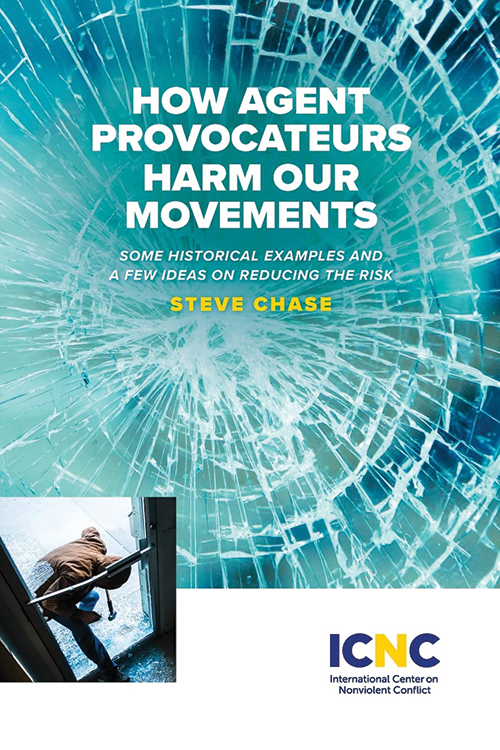
How Agent Provocateurs Harm Our Movements: Some Historical Examples and a Few Ideas on Reducing the Risk
Reviewed by George Lakey
February 1, 2022
By Steve Chase. ICNC Press, 2021. 50 pages. $7.99/paperback; $2/eBook; free PDF available at nonviolent-conflict.org.
In this booklet published by the International Center on Nonviolent Conflict, Steve Chase gives valuable guidance for Friends and others navigating today’s turbulent world of social concerns. As a young Friend in the 1960s, which was also a challenging white-water time for keeping one’s boat right-side up, I learned much from older Friends who advanced Friends testimonies through social movements. Once again, we have younger Friends whose futures are in peril, and many understand that the outcome depends on skillful navigation by social movements. The question is: What does “skillful navigation” look like when we hit the white water?
A big difference between the 1960s and now is that we now have empirically based knowledge from political scientists showing that movements for righteous causes that maintain a nonviolent discipline have twice the chance of success, compared with those who choose violence or wobble a good bit. (My source is Erica Chenoweth’s and Maria J. Stephan’s 2011 Why Civil Resistance Works: The Strategic Logic of Nonviolent Conflict.)
In a discussion about the utility of violence, Friends no longer lack a pragmatic contribution, which formerly forced them to fall back on ethical considerations that might have been irrelevant to others in the discussion. Today we can be like the Friends of yesteryear who were keen on science (Quakers then included a disproportionate number of scientists.); we can happily wade into strategy discussions knowing that the research is “on our side.”
Researcher and writer Steve Chase has been tracking the controversy over whether some social activist violence might be useful, at least for the purpose of defending activists against right-wing armed individuals and militias—a timely question in the United States. As polarization increases, more activists may want to meet that threat by resorting to violence, and that in turn creates more opportunity for local and state governments to employ agents provocateurs who pretend to be activists and use violence that can then be blamed on us.
This is an old, international story, as we can tell by the tactic’s French name. Police in France and many other countries, including the UK and Canada, have done exactly this: sent individuals to blend in with activists, and who then use guns or explosives so that the movement is discredited and loses its support. Chase describes a variety of examples, especially the U.S. use of this tactic to reduce support not only for the labor and peace movements but especially to counter the Black liberation movement of the 1960s and ’70s.
After informing the reader of this tactic, Chase describes a variety of ways we can defend ourselves against it. Wise activists will keep the booklet handy: in organizing ourselves and our demonstrations, we can immunize ourselves by, for example, forming affinity groups and preceding our demonstrations with training.
Peace is like health: it’s a lofty concept that, in fact, implies many practical steps to make it a reality. This new booklet arrives when our country needs as many Friends as possible to be made confident by the tools we bring to the occasion. This new booklet is part of our toolkit.
George Lakey is a member of Central Philadelphia (Pa.) Meeting. A lifelong activist, he has taught peace studies at Swarthmore College and the University of Pennsylvania. Among his books are Facilitating Group Learning (PM Press) and How We Win: A Guide to Nonviolent Direct Action Campaigning (Melville House).


